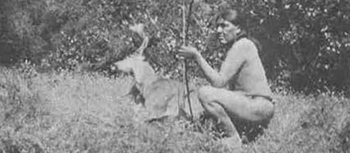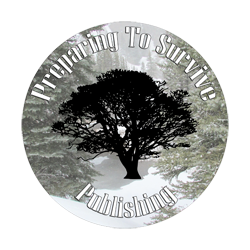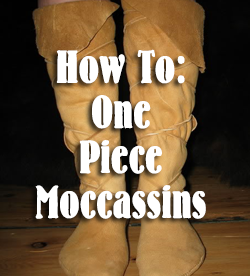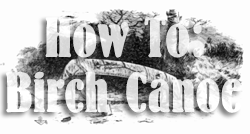
Ishi's Methods Of Hunting
Taken From: Hunting With The Bow And Arrow By Saxton Pope
Ishi, the last Yana Indian, 1916
Hunting with Ishi was pure joy. Bow in hand, he seemed to be transformed into a being light as air and as silent as falling snow. From the very first we went on little expeditions into the country where, without appearing to instruct, he was my teacher in the old, art of the chase. I followed him into a new system of getting game. We shot rabbits, quail, and squirrels with the bow. His methods here were not so well defined as in the approach to larger game, but I was struck from the first by his noiseless step, his slow movements, his use of cover. These little animals are flushed by sound and sight, not scent. Another prominent feature of Ishi's work in the field was his indefatigable persistence. He never gave up when he knew a rabbit was in a clump of brush. Time meant nothing to him; he simply stayed until he got his game. He would watch a squirrel hole for an hour if necessary, but he always got the squirrel.
He made great use of the game call. We all know of duck and turkey calls, but when he told me that he lured rabbits, tree squirrels, wildcats, coyote, and bear to him, I thought he was romancing. Going along the trail, he would stop and say, "_Ineja teway--bjum--metchi bi wi_," or "This is good rabbit ground." Then crouching behind a suitable bush as a blind, he would place the fingers of his right hand against his lips and, going through the act of kissing, he produced a plaintive squeak similar to that given by a rabbit caught by a hawk or in mortal distress. This he repeated with heartrending appeals until suddenly one or two or sometimes three rabbits appeared in the opening. They came from distances of a hundred yards or more, hopped forward, stopped and listened, hopped again, listened, and ultimately came within ten or fifteen yards while Ishi dragged out his squeak in a most pathetic manner. Then he would shoot.
To test his ability one afternoon while hunting deer, I asked the Yana to try his call in twelve separate locations. From these twelve calls we had five jackrabbits and one wildcat approach us. The cat came out of the forest, cautiously stepped nearer and sat upon a log in a bright open space not more than fifty yards away while I shot three arrows at him, one after the other; the last clipped him between the ears.
This call being a cry of distress, rabbits and squirrels come with the idea of protecting their young. They run around in a circle, stamp their feet, and make great demonstrations of anger, probably as much to attract the attention of the supposed predatory beast and decoy him away, as anything else.
The cat, the coyote, and the bear come for no such humane motive; they are thinking of food, of joining the feast.
I learned the call myself, not perfectly, but well enough to bring squirrels down from the top most branches of tall pines, to have foxes and lynx approach me, and to get rabbits.
Not only could Ishi call the animals, but he understood their language. Often when we have been hunting he has stopped and said, "The squirrel is scolding a fox." At first I said to him, "I don't believe you." Then he would say, "Wait! Look!" Hiding behind a tree or rock or bush, in a few minutes we would see a fox trot across the open forest.
It seemed that for a hawk or cat or man, the squirrel has a different call, such that Ishi could say without seeing, what molested his little brother.
Often have we stopped and rested because, so he said, a bluejay called far and wide, "Here comes a man!" There was no use going farther, the animals all knew of our presence. Only a white hunter would advance under these circumstances.
Ishi could smell deer, cougar, and foxes like an animal, and often discovered them first this way. He could imitate the call of quail to such an extent that he spoke a half-dozen sentences to them. He knew the crow of the cock on sentinel duty when he signals to others; he knew the cry of warning, and the run-to-shelter cry of the hen; her command to her little ones to fly; and the "lie low" cluck; then at last the "all's well" chirp.
Deer he could call in the fawn season by placing a folded leaf between his lips and sucking vigorously. This made a bleat such as a lamb gives, or a boy makes blowing on a blade of grass between his thumbs.
He also enticed deer by means of a stuffed buck's head which he wore as a cap, and bobbing up and down behind bushes excited their curiosity until they approached within bow-shot. Ordinarily in hunting deer, the Indian used what is termed the still hunt, but with him it was more than that. First of all he studied the country for its formation of hills, ridges, valleys, canyons, brush and timber. He observed the direction of the prevailing winds, the position of the sun at daybreak and evening. He noted the water holes, game trails, "buck look-outs," deer beds, the nature of the feeding grounds, the stage of the moon, the presence of salt licks, and many other features of importance. If possible, he located the hiding-place of the old bucks in daytime, all of which every careful hunter does. Next, he observed the habits of game, and the presence or absence of predatory beasts that kill deer.
Having decided these and other questions, he prepared for the hunt. He would eat no fish the day before the hunt, and smoke no tobacco, for these odors are detected a great way off. He rose early, bathed in the creek, rubbed himself with the aromatic leaves of yerba buena, washed out his mouth, drank water, but ate no food. Dressed in a loin cloth, but without shirt, leggings or moccasins, he set out, bow and quiver at his side. He said that clothing made too much noise in the brush, and naturally one is more cautious in his movements when reminded by his sensitive hide that he is touching a sharp twig.
From the very edge of camp, until he returned, he was on the alert for game, and the one obvious element of his mental attitude was that he suspected game everywhere. He saw a hundred objects that looked like deer, to every live animal in reality. He took it for granted that ten deer see you where you see one--so see it first! On the trail, it was a crime to speak. His warning note was a soft, low whistle or a hiss. As he walked, he placed every footfall with precise care; the most stealthy step I ever saw; he was used to it; lived by it. For every step he looked twice. When going over a rise of ground he either stooped, crawled or let just his eyes go over the top, then stopped and gazed a long time for the slightest moving twig or spot of color. Of course, he always hunted up wind, unless he were cutting across country or intended to flush game.
At sunrise and sunset he tried always to get between the sun and his game. He drifted between the trees like a shadow, expectant and nerved for immediate action.
Some Indians, covering their heads with tall grass, can creep up on deer in the open, and rising suddenly to a kneeling posture shoot at a distance of ten or fifteen yards. But Ishi never tried this before me. Having located his quarry, he either shot, at suitable ranges, or made a detour to wait the passing of the game or to approach it from a more favorable direction. He never used dogs in hunting.
When a number of people hunted together, Ishi would hide behind a blind at the side of a deer trail and let the others run the deer past. In his country we saw old piles of rock covered with lichen and moss that were less than twenty yards from well-marked deer trails. For numberless years Indians had used these as blinds to secure camp meat.
In the same necessity, the Indian would lie in wait near licks or springs to get his food; but he never killed wantonly.
Although Ishi took me on many deer hunts and we had several shots at deer, owing to the distance or the fall of the ground or obstructing trees, we registered nothing better than encouraging misses. He was undoubtedly hampered by the presence of a novice, and unduly hastened by the white man's lack of time. His early death prevented our ultimate achievement in this matter, so it was only after he had gone to the Happy Hunting Grounds that I, profiting by his teachings, killed my first deer with the bow.
That he had shot many deer, even since boyhood, there was no doubt. To prove that he could shoot through one with his arrows, I had him discharge several at a buck killed by our packer. Shooting at forty yards, one arrow went through the chest wall, half its length; another struck the spine and fractured it, both being mortal wounds.
It was the custom of his tribe to hunt until noon, when by that time they usually had several deer, obtained, as a rule, by the ambush method. Having pre-arranged the matter, the women appeared on the scene, cut up the meat, cooked part of it, principally the liver and heart, and they had a feast on the spot. The rest was taken to camp and made into jerky.
In skinning animals, the Indian used an obsidian knife held in his hand by a piece of buckskin. I found this cut better than the average hunting knife sold to sportsmen. Often in skinning rabbits he would make a small hole in the skin over the abdomen and blow into this, stripping the integument free from the body and inflating it like a football, except at the legs.
In skinning the tail of an animal, he used a split stick to strip it down, and did it so dextrously that it was a revelation of how easy this otherwise difficult process may be when one knows how. He tanned his skins in the way customary with most savages: clean skinning, brain emulsion, and plenty of elbow grease.
His people killed bear with the bow and arrow. Ishi made a distinction between grizzly bear, which he called _tet na_, and black bear, which he called _bo he_. The former had long claws, could not climb trees, and feared nothing. He was to be let alone. The other was "all same pig." The black bear, when found, was surrounded by a dozen or more Indians who built fires, and discharging their arrows at his open mouth, attempted to kill him. If he charged, a burning brand was snatched from the fire and thrust in his face while the others shot him from the side. Thus they wore him down and at last vanquished him.
In his youth, Ishi killed a cinnamon bear single handed. Finding it asleep on a ledge of rock, he sneaked close to it and gave a loud whistle. The bear rose up on its hind legs and Ishi shot him through the chest. With a roar the bear fell off the ledge and the Indian jumped after him. With a short-handled obsidian spear he thrust him through the heart. The skin of this bear now hangs in the Museum of Anthropology in mute testimony of the courage and daring of Ishi. Had this young man been given a name, perhaps they would have called him Yellow Bear.
While he shot many birds, I never saw Ishi try wing shooting except at eagles or hawks. For these he would use an arrow on which he had smeared mud to make it dark in color. A light shaft is readily discerned by these birds, and I have often seen them dodge an arrow. But the darker one is almost invisible head on. The feathers of the arrows were close cropped to make them swift and noiseless.
The sound of a bowstring is that of a sharp twang accompanied by a muffled crack. To avoid this and make a silent shot, the Indian bound his bow at the nocks with weasel fur; this effectually damped the vibration of the string, while the passage of the arrow across the bow, which gives the slight crack, is abolished by a heavy padding of buckskin at this point.
Ishi never wore an arm guard or glove or finger stalls to protect himself as other archers do. He seemed not to need them. When he released the arrow, the bow rotated in his hand so that the string faced in the opposite direction from which it started. His thumb alone drew the string, and this was so toughened that it needed no leather covering.
In a little bag he carried extra arrowheads and sinews, so that in a pinch he could mend his arrows.
When not actually in use, he promptly unstrung his bow, and gently straightened it by hand. In cold weather he heated it over a fire before bracing it. The slightest moisture would deter him from shooting, unless absolutely necessary--he was so jealous of his tackle. If his bowstring stretched in the heat or dampness, as sinew is liable to do, he shortened it by twisting one end prior to bracing it.
Before shooting he invariably looked over each arrow, straightened it in his hands or by his teeth, re-arranged its feathers, and saw that the point was properly adjusted. In fact, he gave infinite attention to detail. With him, every shot must count. Besides arrows in his quiver, he carried several ready for use under his right arm, which he kept close to his side while drawing the bow.
In all things pertaining to the handicraft of archery and the technique of shooting, he was most exacting. Neatness about his tackle, care of his equipment, deliberation and form in his shooting were typical of him; in fact, he loved his bow as he did no other of his possessions. It was his constant companion in life and he took it with him on his last long journey.




